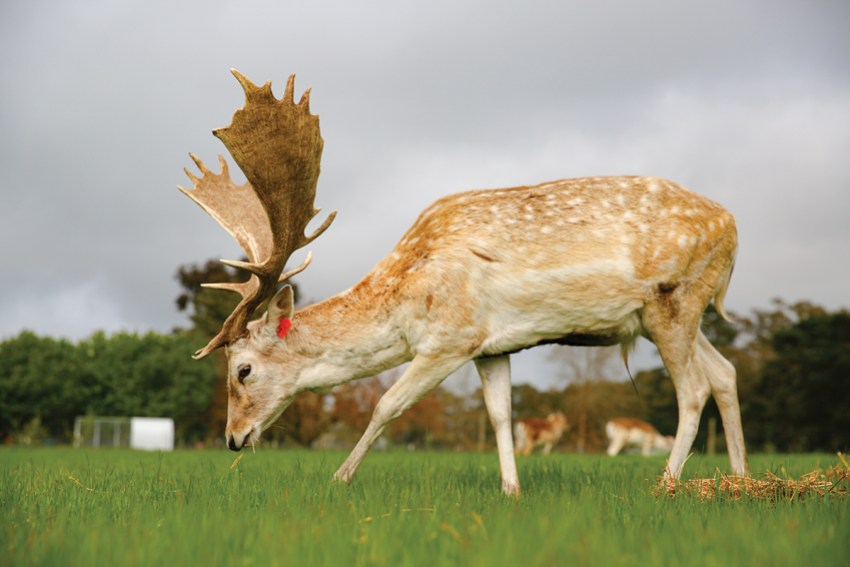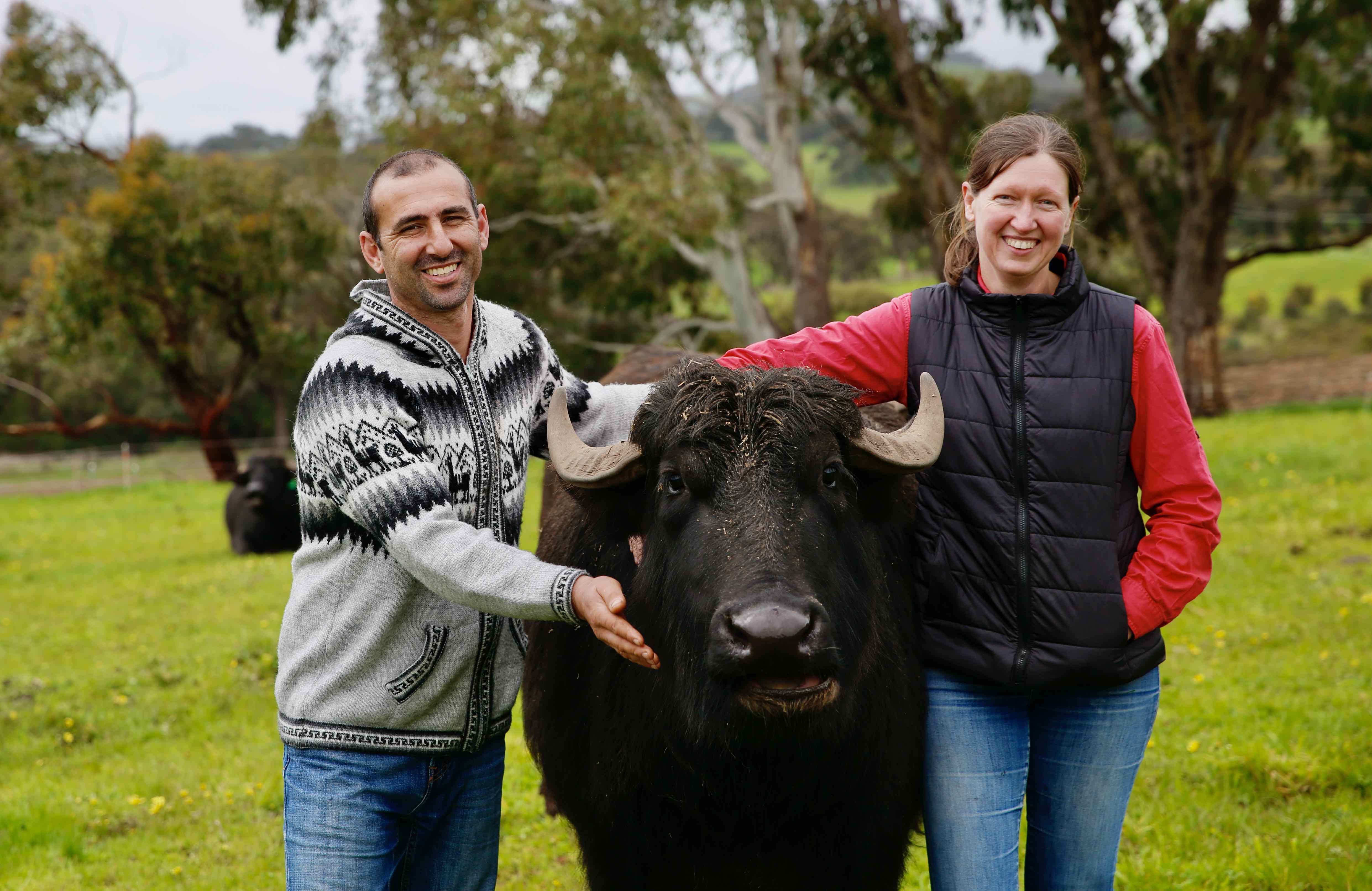Rather than follow the herd, these dedicated South Australian producers are farming unique animals that provide on-farm benefits and premium produce in return for some love and care.
Fantastic beasts and where to find them
Greener pastures
When driving through the lush green farmland outside of Birdwood, you might do a double take when the passing paddocks of sheep momentarily give way to a large herd of majestic antlered creatures.
Here, on 30 hectares of pasture bordered by unusually high fences and trees, the Kasprzak family has been breeding deer for the past 35 years.
In recent years, school teacher Leila Kasprzak has been taking over operations of The Deer Farm from her parents Mike and Nancy who, in 1987, established the farm primarily as a stud to sell bucks and does to other farms.
Leila and her two sisters grew up on the property where they were initiated to farm life at an early age.
“I was the girl at school who had venison sandwiches and I would try to swap them with other kids for Vegemite,” says Leila.

“We put up new fences when I was about 10 years old and it took us six months, every weekend and on evenings in summer. Then there was ear tagging, sorting animals and drafting; there has always been jobs to do as kids out there in the yards with Dad.”
As Leila drives her buggy out onto the paddock, the deer tentatively flock to the vehicle, lured by the promise of food. There is one rogue kangaroo among the herd – he jumped over the fence once and never left.
“For us, it has never been just about making money, it’s about the passion and interest in the care of the animals,” says Leila.
Fed on pasture, hay and grain, the deer have a good life on the sprawling farm with the family doing everything they can to minimise stress for the animals, overseeing the processing of venison meat at a local abattoir.
“The deer that don’t make the grade, the ones that are excessively flighty or hard to yard, they become venison which provides an income to look after the rest of the deer,” says Leila.
She says venison is a necessary by-product of maintaining their stud which also brings in an income from antlers. Deer antler is one of the fastest growing tissues in the animal kingdom, with the bucks naturally casting, or dropping, their antlers every year. During SALIFE’s visit, Leila plucks a newly-cast antler off the ground.
It takes a buck just 100 days to grow an impressive set of antlers, equipped for the rut when they fight for mating rights.

Their bodies become lean as their necks thicken up for fighting.
Then, they naturally drop their antlers in spring and their bodies return to normal.
“It’s astounding when you consider how much weight is in their antlers. Out in the field, they’ll flick their heads around like it’s nothing.
“They are beautiful. It’s great at the end of the day, especially when it’s not too rainy and muddy, getting on the quad with the dogs and driving through the paddocks.
“The deer look stunning in summer when their spots and ginger coats come out. Right now, they’re dropping their winter coat so they look scruffy.”
In the ‘80s, Leila’s parents started with a small number of the common fallow deer and their breeding program has refined the temperament across the herd so that they are now much calmer around people.
“Deer are flighty by nature. They can jump very high, hence our fences, and we have had injuries. Their feet are like razors, they’re very sharp, so it’s important that they’re behaved and not throwing themselves around when we round them up.”
They have also interbred the larger Persian deer, combining the large body size of the Persians with the wonderful antlers produced by the fallows.

The family has previously sold venison to chefs including Alana Brabin, Toby Gush, Kane Pollard and Jake Kellie. And there was a time when Africola’s Duncan Welgemoed was taking as much fresh venison chorizo as they could produce.
COVID put a hold on that, and the family has survived thanks to the Barossa Farmers Market at Angaston where they sell venison smallgoods, meat and Nancy’s hand-made venison pies under the Birdwood Venison label.
A prime set of antlers can sell from $600, while damaged or poor-quality antlers are cut up and sold as dog chews. “We sell the great sets to people who use them as decor. We once had a ‘white witch’ purchase one as a wand.
“We are driven to be ethical with a nose-to-tail approach. We make sure they have a good life, they’re fed by hand with grain every day, and if they’re going to give us their life for meat, we need to be respectful to the animal.”

The cream of the crop
They certainly look tough with their deep black eyes glowering from beneath their hooked horns and imposing 700-kilogram frames, but Beatrice, Cadbury, Violet and Tulip are all big softies.
Emma Rooke and Eric Oxenham have been getting to know their growing herd of Italian buffalo since they started with just six animals in 2018. They now have 35 “buffs” including 10 calves.
Although buffalo are an unusual sight on the Fleurieu, Italians have been milking buffalo for centuries, particularly in Campania – the home of mozzarella di bufala campana.
Emma and Eric now produce milk, fetta, haloumi and yoghurt under their Buff Love label, which can be found at the Willunga and Adelaide Showgrounds farmers markets.
The couple still work their day jobs – Emma is a veterinary epidemiologist, and Eric is an IT professional – and hope to become full-time farmers.

“As a dairy farmer, you have such an intimate relationship with the animals. You know them all really well and as soon as you get into the yards in the morning, you can tell who’s cranky or who’s having a good day. They’ve all got different personalities; they’re so individual,” says Emma.
“Like any large animal, you must treat them respectfully and we spend a lot of time training them. Now, most of our buffalo really enjoy pats and being handled.
“They’re a bit shy around new people but when Eric goes into the paddock, our bull, Rainbow rolls over for him like a dog. He just loves getting pats and Eric’s a real buffalo whisperer it turns out.”
Previously from Canberra, Emma and Eric chased the rural lifestyle to Adelaide where they could buy land close to the city.
Buffalo seemed a great choice as it would allow them to produce a premium product with a small herd.
“Getting into farming is a huge capital investment. Land and infrastructure are expensive and so, with our small parcel of land, we knew we’d have to do something fairly niche to make it financially viable,” says Emma.

The first few years have been a labour of love, investing their time, energy and money into setting up the paddocks, milking shed and dairy. Not to mention copping the occasional headbutt, or a “happy horn” as Eric likes to call it, and plenty of wet tail slaps in the face on morning milking duties.
“It’s always wet here in winter. When you’re in the dairy and they’re whacking you in the face with their wet tails, you don’t mind it every now and then, but every morning it starts to get a bit wearing,” laughs Emma.
“Cows will run away from you, but these guys will front you up, which can be a bit confronting. I wasn’t sure about it when we first started handling them, but you get to know their behaviour and they come to respect you, which is important.”
Emma is qualified in artisan cheese production and creates her products in a modified shipping container on the property.
Interest is growing in Buff Love products and Emma’s goal is to create a traditional buffalo mozzarella this year. The couple is also looking into the potential of hosting farm tours.

They say because buffalo milk has a different protein to dairy milk, some people who have difficulty digesting dairy can find buffalo milk gentler on their stomachs. While the focus of the farm is milk and cheese, they do produce meat, too.
Emma and Eric have embarked on research trips to Italy and hope to travel there again next year to learn even more about buffalo farming and cheese making.
“What we really want to make is a really nice, traditional mozzarella, that’s our target,” says Emma.
“We started with some cheeses which we now have a regular following for and we’re supplying a couple of restaurants.
“There’s a lot of interest in our products and the business right now, which is exciting.”

The fibre of the gods
Just a short drive south of Willunga, pharmacist Lee Sadler and her family run an alpaca stud with 300 head of the mighty Peruvian camelid grazing on the sweeping tree-lined pastures of their property.
Lee’s alpacas may not look their fluffy best on a particularly wet day but peeling back a soggy coat of one alpaca reveals a perfectly dry and warm interior, demonstrating the superior nature of alpaca fleece – one of the world’s most prized natural fibres.
Having farmed alpacas for 25 years, Lee is a passionate advocate of the many benefits of farming alpaca, not just for their luxurious fleeces, but also for the better management of farm ecosystems.
Less damaging on pastures than sheep or cows with fleece that is in many ways superior to merino wool, the alpaca is an attractive livestock option that was only introduced to Australia in the late ’80s. In recent times, interest in alpaca fleece has surged.

“There are many benefits of having alpaca as livestock. The weight of each foot on the ground is less than that of a kangaroo and they don’t have cloven feet like cows and sheep and therefore aren’t as bad for pastures,” says Lee.
“When they graze, their teeth sheer the grass, so they don’t challenge the root mass as badly as sheep do. When I rest my paddocks and we get a shower of rain, they regenerate very quickly.”
A smaller cousin of the llama, alpacas are native to Peru where they live at high altitudes in the South American Andes. Their warm fleece keeps them insulated from the cold, snowy climate.
The thread from their coats is warmer than any other kind of wool fabric. It is finer, smoother, stronger, lighter and warmer than merino. It’s also hypoallergenic.
“It’s so soft and light. It’s the most insulating natural fibre in the world and is being used to make all sorts of interesting and innovative things as well as fine garments. It comes in a range of natural colours so you can have a garment that is coloured but undyed,” says Lee.

Lee says they do make good eating, but the market for alpaca meat is very small in Australia. In Peru, it is the principal source of protein. “Meat is only a small part of my business; our alpacas get to make old bones,” she says. “The practicality of eating alpacas is there, but Australians are sentimental people and alpacas have a cuteness factor.”
Lee and her husband Greg Scarlett have great support on the farm from their sons Alexander and Luke, who have acquired a valuable upbringing on the land. “The boys are great with animals and are competent horse riders as well,” says Lee.
“They can back a float and drive the tractor and have gone out into the world with all these skills they’ve learnt along the way.
They understand about looking after the land and if you look after the land, it will look after you.”
This story first appeared in the November 2022 edition of SALIFE Magazine.



